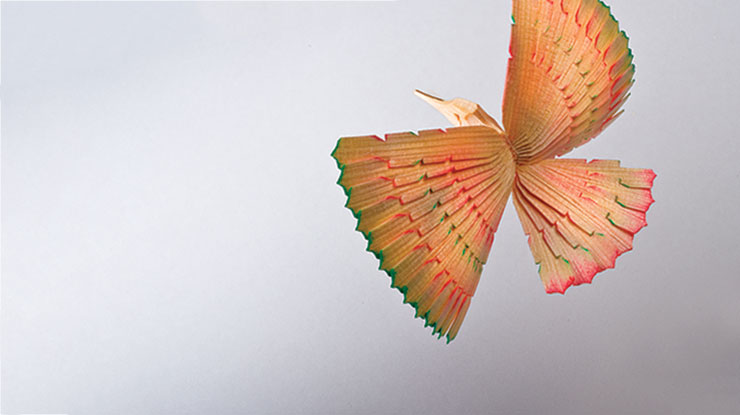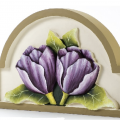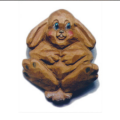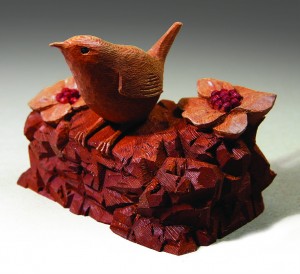
By Chris Pye
Carving in the round means exactly that: carving the subject completely three dimensionally. You can view the carving from any direction. In some ways, in-the-round carving is easier than relief because the perspectives and proportions will be true. Relief carving often needs distortion or perspective to allow for the single viewpoint.
It’s often helpful with more complicated in-the-round work to make a model in clay or Plasticene. This preliminary model helps you visualize the finished carving and aids in deciding how to use grain strength in the design. By making the model to scale, you can use it to create a working drawing and transfer measurements to the wood.
Design Considerations
When carving in the round, you have to pay attention to the grain (the wood fibers) and how their strength works with the design. With this wren, the two thinnest, and potentially weakest, elements, the tail and beak, are at right angles to each other.
Long wood fibers give strength to any element, but if we run them into the tail we must have short fibers in the beak, which would make the beak very weak. The beak is the most vulnerable element, so maximize its strength by running the grain along it. Angle the tail back as much as the character of the bird will allow. The wood fibers now run more diagonally through the tail, rather than across it at right angles. Keep the tail as thick as the design will allow, especially front to back, and take special care of the tail during the carving process.
Little bird legs are very thin (and normally added using brass rods by bird carvers), so I decided to tie the spindly legs to the wooden rocks carved beneath them. All of these design considerations are part of the challenge of carving. A design may need modifying or compromising to be suitable for carving in wood.
Materials:
Wood, 4″ x 4″ x 3 1/2″ (102mm x 102mm x 89mm)
Coffee (to stain wood)
Dye, water-based: red (flower centers)
India ink, black (eyes)
Danish oil
Varnish, matte acrylic
Tools:
Regular Gouges
#1 Chisels, 1/4″, 1/2″ (6mm x 13mm)
#3 Gouges, 1/8″, 1/4″ (3mm x 6mm)
#6 Gouges, 1/4″, 1/2″ (6mm x 13mm)
#8 Gouges, 1/16″, 1/4″, 3/8″ (2mm x 6mm x 10mm)
60° V-tools: 1/8″, 3/8″ (3mm x 10mm)
Chisels, skew: 1/8″, 1/4″ (3mm x 6mm)
Bench vise
CLICK HERE to download the Wren in the Round Pattern.
| About the Author |
| Chris Pye is a master woodcarver, instructor and author of several books, including Woodcarving Projects and Techniques, produced by Fox Chapel Publishing. Chris runs the video-based teaching website, WoodcarvingWorkshops.tv, with instruction on tools, sharpening, lettering, relief carving, in-the-round projects and much more; and from where he writes a free monthly blog about woodcarving. You can see a gallery of his commissioned work at www.chrispye-woodcarving.com. |
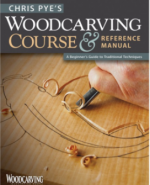 Read Chris Pye’s Woodcarving Course & Reference Manual for more information about general carving techniques. A comprehensive guide for those who want to learn carving, this manual provides a handful of lessons, including how to choose the best woods, safe tool handling tips, making cuts, and executing a variety of techniques. It is available for $19.95 plus S&H at www.foxchapelpublishing.com.
Read Chris Pye’s Woodcarving Course & Reference Manual for more information about general carving techniques. A comprehensive guide for those who want to learn carving, this manual provides a handful of lessons, including how to choose the best woods, safe tool handling tips, making cuts, and executing a variety of techniques. It is available for $19.95 plus S&H at www.foxchapelpublishing.com.
Read more great articles from 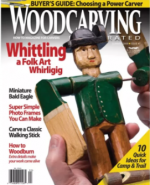 Woodcarving Illustrated Summer 2009 (Issue 47) here.
Woodcarving Illustrated Summer 2009 (Issue 47) here.


